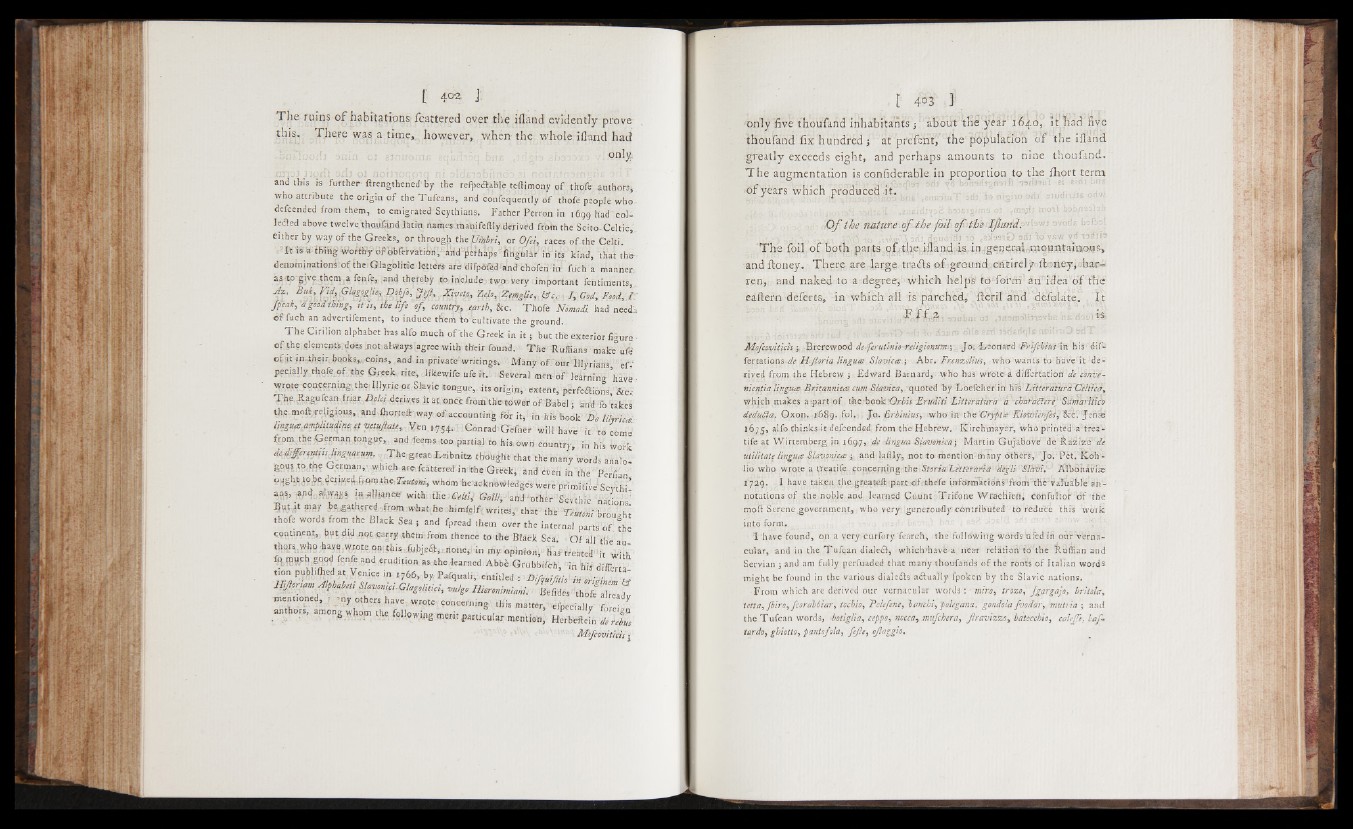
The ruins o f habitations icattered over the iilànd evidently prove
ìniÉ was 2 time,, however, when- the whole ifland had
only
and this is further-ftrengthtned'by the refye£^able teftimony q f thpfe authors^
who attribute the origin of the Tufeans, and conÌ'eqùently df thofe people who.
defcended from them, to emigrated Scythians. Father Perron in 1699 had'col-
lefled above twelve-thoygnd iatin namesithatnfeftlyiderived from the Scrto-Celtic,.
either by way of the Greeks, or through the Umbri, or Ofe\, races of the Celiti,
i t ida-fBiHgworéSy’dPpbfervarite^àdd'^èlhajìs Ttngùlàr Tri its kind, that thfe--
dejratainationiloftheiGiagoliric leiteWàrèdtfpàfd3fknd'choYeri in fuch a manner
as;to give them a fenfe, and thereby to include:; two very important fcntiments, it AW » r a p
jpeaky 'a gooatnivg, U ; s , th h f i 'o f , Thofe 'Nòmadi, had needh
¿ f fuch an advertifemènt, to induce tiem to cultivate the ground.
T h e Cirilion alphabet has alfo much of'the Greek' in it ; but the exterior fiiure •
of^hy giepieptkdoes inot .always :agree -with their found. The Ruffians mafeufo
of8trn.tbfiirhqoksw cprns, and in privateVritings, Many o f’ our’Illyriah's ef
pecjally thofe of.-yhe Greek rite, likewife ufe it. Severa! men o f learning ill
v yrnt^o^rfttnffitbe;Iilytic«.Stevie tongue,.itsorigin, extent, pdrfoafons, & c :
it at, once fròm'th'es-towér ofdBdbdl ~ hud % 'talceS
Tnd>ftortea;wayc«fiaccounting ig r it*rin B^Bodk Be ¡11^
will babe it to come
f s m & s & s m h m s v * m i country, ih hé feoik
the Mil ^
« himfelf. writes, that '
thofe words from the Black Sèa ; and fpread them over the internal partì'oTi flie
c9Pi“ ,n.ePi>; HP 6 « # a fo# jjWl i«MM ÌSé» thence to-die Black SdS m U
«ent.oned, , Jny others bave.. wfofo concerning this matter efoeciallv f
authors, amoogwhopt the. mentios’ S i “
‘ Mòfcoviticìs 1
^orily fiv e thou'fand in h a b ita n t s p a b o u t tKé y e à r 184.0^ it^ a id liv e
th o u fa n d f ix h u n d red ; a t p r e fè t ìf i th e p ó p u là t iò n o f m e ifla n d
;g r e a t ly e x c e e d s e ig h t , and p e rh ap s .am o u n ts to n in e th o u fan d -
T h e a u gm e n ta t io n is co n fid e ra b le in p r o p o r t io n to th e ih o r t te rm
o f y e a r s w h ic h p ro d u c ed i t .
O f the nature \cjfjhe foih ofithe /florida £ ;
t s i f f z u r s i .y^SS io ' èriJ rfsuófm io {2:?b3iO ari) io
‘T h e fo il, o f b o th p a r ts p |4 i|^ e^ à i> ìdi‘fe F-tndg^9^if^o^OB^[tai'0iOjqiS>
and ilo n e y . T h e r e are la r g e - t r a if s o f grouiridsenti r e 1 yoibsriey^afeafe£
r e n , and n a k e d to a degree^ w h i c h h:e lp s ! to T o r n i ; a r i i d è à ò f t k e
eàftern d e fe r ts , in w h ic h a ll is p a r c h e d , ; i l e n l a n d -dè ib la te. I t
,, -,r.V}- ■ ‘joubai 01 ttnarnaib’iovbfi n£. rioui^
Mofco v iù c ìsBrerewood defcrutìnio°religìonitìnyc Jo; 'LcoriaYd 'P/ftbitìs itì his difc
fertations^ Hjloria lingua S l a v i c a Abr. Frtnzèlius, whfrwants to have it derived
from the Hebrew ; Edward Barnard,, who has wrote a differt'ation decònye-
nientialingua Britannica cum Slavica, quoted by I/oeffcher in his Litteràtiird Celticày
which makes appare of the-hook’-Orbis Eruditi Lìtteraiura à 'cWr'à'éÌefì' Sà'marlÀSo
dedu£ìa. Qxon. 1^ 9 . ,foI,-, Jo. Erbimus, who in' tht ’Crypta 'fLioiifiìnfèìj 8cé(. :Jeh*
1675, alfo thinlcs it defcended from the Hebrew. Kirchmàyer, who printed a 'trea-
tife at Wirtemberg in 16,97, de lingua Siavonica j Martin GujaBoVé de -Razìze' de
ùtilitate lingua Slqvpnjfa y anH; laÌlty^ not to mention-many xS'tKèfs,': 'Jo. Pét, K-oh -
Irò who wrote a pea ti fe^owerningr ith.e ''^tùria'Xik^t’àAd1 fyVgli- ÀÌbShaV'iae
•1729. I have taken th^gr.eat^ftipart ©ìfrthelfe ipisfo'Yliiat-f6fns^fr'omr,cHè5va:faab]!é; ah’--
notations of the noble and, learned C.auntr Trifone WràcHién, éònfiiitor:ld?f 'thè
•moil Serene government, who very Igenetoufly! contributed tò reduce this work
into form.
i have found, on a very curfory fearch, the following wòt'ds ùièd id our vernacular,
and in the Tufcan dialeit-, which.'have-a. near reiatt'ori fó/the ’Rdilian and
Servian ; and am fully perfuaded that many thoufands of the roots of Italian words
might be found in the various diale&s a&ually fpokèn by the Slavic nations.
From which are derived our vernacular words ‘. •'miro, tro zo , fg a r g a jo , t r ito la ,
te tta , /biro , feo ra b b ìa r , tOchio, Bclcfeh'e, 'banchi, 'polegana. gondola fv o d a r , m utria ; and
theTufcan words, >botiglia, ceppo, nocca, mufehera, J ìr a v iz iz o , batocchio, calejfe, t a f -
tardo, ghiotto, p antofola, f e j l e , ojìaggio.